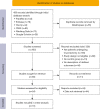Effect of the enhanced recovery after surgery protocol on recovery after laparoscopic myomectomy: a systematic review and meta-analysis
- PMID: 35694088
- PMCID: PMC9177272
- DOI: 10.21037/gs-22-168
Effect of the enhanced recovery after surgery protocol on recovery after laparoscopic myomectomy: a systematic review and meta-analysis
Abstract
Background: Surgery is the recommended treatment for uterine leiomyoma but it still has issues like postoperative complications and slow recovery. The enhanced recovery after surgery (ERAS) protocol could probably reduce traumatic stress and promote the rapid postoperative recovery of patients, but there are controversies for the results of different studies. This meta-analysis was performed to resolve the controversies and provide evidence for the application of ERAS in gynecology.
Methods: The PubMed, Embase, Ovid, CNKI (China), Wanfang Data (China), and Google Scholar databases were searched to recruit all studies on the application of ERAS in laparoscopic myomectomy up to November 2021. The inclusion criteria of studies was established according to the PICOS principles. the Cochrane RoB 2.0 and Newcastle-Ottawa Scale (NOS) scale were used to assess the bias of the studies, RevMan 5.3 software was used for meta-analysis.
Results: Ten studies that met the criteria were finally included with 1,441 participants. Eight of them were randomized controlled trials (RCTs) and two were cohort studies, all of them were with low level of bias. Meta-analysis showed that ERAS protocol after laparoscopic myomectomy could significantly shorten the first time getting out of bed after surgery [mean difference (MD) =-4.85; 95% confidence interval (CI): (-7.35, -2.36); P=0.0001], the first defecation time after surgery [MD =-4.69; 95% CI: (-5.68, -3.69); P<0.00001], and the postoperative hospital stay [MD =-1.32, 95% CI: (-2.08, -0.56); P=0.0007]. It could also markedly reduce the patient readmission rate [odds ratio (OR) =0.42; 95% CI: (0.23, 0.76); P=0.004], and notably reduced the incidence of complications [OR =0.37; 95% CI: (0.22, 0.61); Z=3.82; P=0.0001]. Yet, the cost of the ERAS protocol was not significantly different from that of routine care [MD =-127.76, 95% CI: (-997.19, 741.66); P=0.77].
Discussion: The application of ERAS protocol after gynecological laparoscopic myomectomy can shorten the first defecation time, first time out of bed, hospital stay, and reduce the readmission rate as well as the incidence of postoperative complications, without additional costs. But still there was heterogeneity among the studies, the topic still deserved further exploration.
Keywords: Enhanced recovery after surgery (ERAS); laparoscopy; myomectomy.
2022 Gland Surgery. All rights reserved.
Conflict of interest statement
Conflicts of Interest: All authors have completed the ICMJE uniform disclosure form (available at https://gs.amegroups.com/article/view/10.21037/gs-22-168/coif). The authors have no conflicts of interest to declare.
Figures









Comment in
-
Is enhanced recovery after surgery protocol has high value in after laparoscopic myomectomy?Gland Surg. 2022 Aug;11(8):1431-1432. doi: 10.21037/gs-22-334. Gland Surg. 2022. PMID: 36082092 Free PMC article. No abstract available.
Similar articles
-
[Meta-analysis on safety of application of enhanced recovery after surgery to laparoscopic bariatric surgery].Zhonghua Wei Chang Wai Ke Za Zhi. 2018 Oct 25;21(10):1167-1174. Zhonghua Wei Chang Wai Ke Za Zhi. 2018. PMID: 30370517 Chinese.
-
Is the Enhanced Recovery After Surgery (ERAS) Program Effective and Safe in Laparoscopic Colorectal Cancer Surgery? A Meta-Analysis of Randomized Controlled Trials.J Gastrointest Surg. 2019 Jul;23(7):1502-1512. doi: 10.1007/s11605-019-04170-8. Epub 2019 Mar 11. J Gastrointest Surg. 2019. PMID: 30859422 Review.
-
Application of single-port procedure and ERAS management in the laparoscopic myomectomy.BMC Womens Health. 2023 Aug 1;23(1):401. doi: 10.1186/s12905-023-02550-6. BMC Womens Health. 2023. PMID: 37528370 Free PMC article.
-
Enhanced recovery after surgery programs versus traditional perioperative care in laparoscopic hepatectomy: A meta-analysis.Int J Surg. 2016 Dec;36(Pt A):274-282. doi: 10.1016/j.ijsu.2016.11.017. Epub 2016 Nov 10. Int J Surg. 2016. PMID: 27840308
-
In-bag manual versus uncontained power morcellation for laparoscopic myomectomy.Cochrane Database Syst Rev. 2020 May 6;5(5):CD013352. doi: 10.1002/14651858.CD013352.pub2. Cochrane Database Syst Rev. 2020. PMID: 32374421 Free PMC article.
Cited by
-
Sixth Annual Enhanced Recovery After Surgery Symposium highlights: work in progress or standard care?Proc (Bayl Univ Med Cent). 2023 Jun 22;36(5):651-656. doi: 10.1080/08998280.2023.2221112. eCollection 2023. Proc (Bayl Univ Med Cent). 2023. PMID: 37614867 Free PMC article. Review.
-
Clarification of issues brought up by 'Is enhanced recovery after surgery protocol has high value in after laparoscopic myomectomy?'.Gland Surg. 2022 Aug;11(8):1433-1434. doi: 10.21037/gs-2022-02. Gland Surg. 2022. PMID: 36082098 Free PMC article. No abstract available.
-
Is enhanced recovery after surgery protocol has high value in after laparoscopic myomectomy?Gland Surg. 2022 Aug;11(8):1431-1432. doi: 10.21037/gs-22-334. Gland Surg. 2022. PMID: 36082092 Free PMC article. No abstract available.
-
Enhanced recovery after surgery (ERAS) guided gynecologic/oncology surgery - The patient's perspective.Gynecol Oncol Rep. 2024 Sep 16;55:101510. doi: 10.1016/j.gore.2024.101510. eCollection 2024 Oct. Gynecol Oncol Rep. 2024. PMID: 39323937 Free PMC article.
References
LinkOut - more resources
Full Text Sources
Miscellaneous
